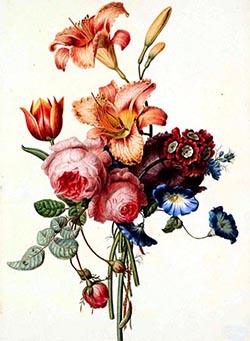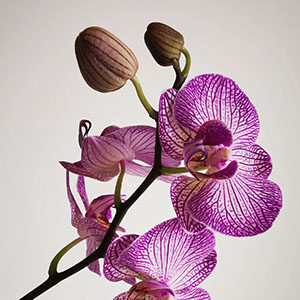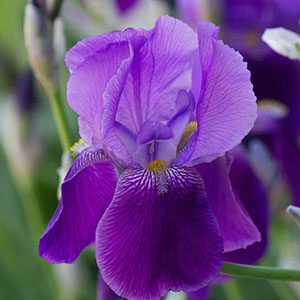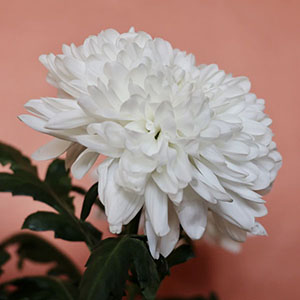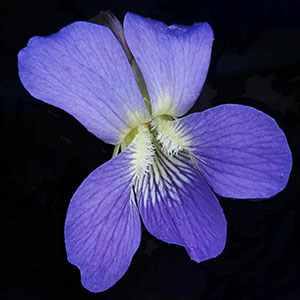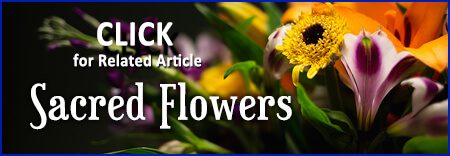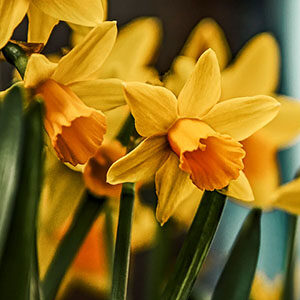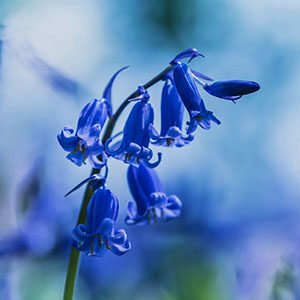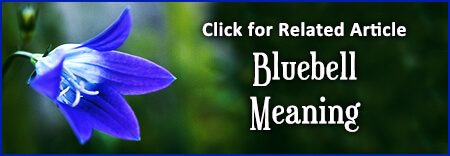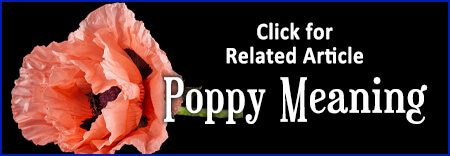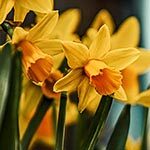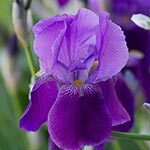
Symbolic Flowers
How to Find the Perfect Flower for Every Occasion
Symbolic flowers are everywhere in art and décor! Flowers are among the most ancient objects used for decorative purposes. They are an endless source of inspiration for poetry, stories and myths. Symbolic flowers have been important as far back as we can trace the life of man.
Share this page with a friend!
Symbolic Flowers in History
Symbolic flowers go back millennia in cultures around the world. For example, rose wreaths have been unearthed in ancient Egyptian tombs. In addition, the symbolism of the lotus played an important role in the ancient Egyptian religion. In other cultures, Confucian and Buddhist religious documents contain references to roses.
Symbolic Flowers in Ancient Times
Flower remains and essential oils have been found in ancient burial sites. Paleobiologists have found flower fossils dating back 120 million years. In fact, archeologists have uncovered a grave site in a cave in Iraq that included flower remains.
Symbolic Flowers Used in Burials
Neanderthals of the Pleistocene cave-dwelling epoch appear to have placed bunches of symbolic flowers on grave sites. This may indicate that symbolic flowers were part of major rites of passage in the earliest possible social structures. The pollen found at the grave site indicates that a wide range of flowers were present as part of the burial ritual.
Rose Petals in Ancient Rome
For the Romans, the rose was associated with the goddess Venus. Nero, the Roman emperor in the 1st century AD, literally used tons of rose petals to impress his dinner guests. Cleopatra had her living quarters filled with rose petals to impress Marc Anthony. Roman women believed that roses would remove wrinkles if used in poultices.
Flower Festivals in Rome
Rose petals were also dropped in wine to counteract drunkenness. Victorious Roman armies were showered with rose petals as they paraded through the streets. In ancient Rome, flower festivals were held in honor of the goddess Flora. Both men and women were awarded flower wreaths for victory in athletic competitions.
Symbolic Flowers in Medieval Times
During the Medieval and Early Renaissance Ages from the 13th to the 15th century, symbolic flower and plant symbolism developed as a way of teaching religious truths. For example, the ivy is an evergreen and symbolized eternal life. A peach symbolized truth and salvation and was used in place of the maligned apple of Adam and Eve.
Popularity of Symbolic Flower Paintings
Flower paintings gained in popularity in the 17th through 19th centuries. Historically, flower symbolism emphasized the notion that the delights of this world are transitory and perishable. This was in keeping with many centuries of religious art utilizing symbolic flowers that focused on the joys of the next world and the trials and tribulations of this one.
The Victorian Language of Flowers
The use of flowers to represent emotions was developed to a high degree during Victorian times. Due to the strict protocol of that era, emotions were not openly expressed between men and women. Instead, an elaborate language based on flower symbolism was developed.
Naming Girls After Symbolic Flowers
The beauty of flowers also inspired the tradition of naming girls after flowers. Popular girls’ names related to flower meanings include Lily, Holly, Violet, Heather, Fern, Jasmine, Myrtle, Lavender, Rose, and Daisy (more at Daisy Meaning).
Symbolism in the Victorian Era
During the Victorian era, gifts of either single flowers or bouquets conveyed clear messages through flower language to the recipient. In addition, flowers adorned nearly everything. This included hair, clothing, jewelry, home interiors, china plates, stationary, wallpaper and more.
The Meaning of Flower Scents
Flower meanings were even associated with scents. For example, a scented handkerchief might be given in place of actual flowers. The importance of flowers as perfume throughout history is highly significant. Flowers also carry religious and spiritual significance in many traditions. Learn more in our article on Sacred Flowers.
Symbolic Flowers in Interior Décor
The significance of symbolic flowers increased in the Victorian era and with advent of the Impressionists. Symbolic flower paintings were everywhere: murals, fabrics, costumes, calligraphic art, illustrations, interior accessories and more. The unending variations of flower forms kept the interest in flower paintings high as new flowers were imported from the East and the New World.
Choosing Floral Art and Gifts
The Victorian language of flowers is an example of detailed symbolism invested in a particular subject. Keep in mind that artwork for interior décor can be chosen with symbolic flowers in mind. Choosing an image or gift based on symbolic flowers for yourself or someone you love encapsulates the values or feelings that you want to convey.
Over 100 Beloved Symbolic Flowers
Flower language assigns symbolic meaning to a wide variety of flowers. The color, form, fragrance and other factors contribute to flower meaning. Some form of flower language is present in nearly all cultures. The practice of assigning meaning to flowers began as early as recorded history and reached a pinnacle as the Victorian flower language.
Symbolic Flowers and Life Events
Flowers accompany us in every major event in life: birth, holidays, graduations, marriage, illness, and death. Find the meanings of over 100 favorite flowers categorized by topic below. Since many flowers have multiple meanings, some flowers may appear in more than one category. Knowing flower language will help you to find the right flower for any occasion, person or holiday!
Symbolic Flowers Meaning BEAUTY
The inherent beauty of flowers themselves has made them symbols of beauty the world around. Some of these flowers grow in many climates while others grow only in a few temperature zones. As a result, there are a number of flowers meaning beauty. This allows each nation, people and climate to claim a flower meaning beauty for their own!
More Symbolic Flower Resources
Brief descriptions are given below and links are included in the table for longer articles on selected flowers. Among the flowers meaning beauty, you can find full articles on Calla Lilly Meaning, Daisy Meaning and Orchid Meaning.
| Acacia Flower | Alyssum | Amaryllis |
| Anemone | Apple Blossoms | Calla Lily |
| Cowslip | Daisy | Gladiola |
| Hibiscus | Honeysuckle | Lilac |
| Myrtle | Orchid | Rose |
Acacia Flowers: Acacia flowers mean perseverance and regeneration. The beauty of acacia flowers is related to purity and spiritual qualities. The quality of endurance is also associated with acacia flowers.
Alyssum Flowers: Alyssum flowers mean “worth beyond beauty” or the beauty of the soul. Alyssum is said to bring emotional balance in gardens, homes and offices. This is a sharp contrast from the Greek name meaning “rage” or “madness”!
Amaryllis Flowers: Amaryllis flowers mean pride, strength and determination. they are also symbols of stunning beauty and love. The name amaryllis is a Greek word meaning “to sparkle.” A pink amaryllis symbolizes friendship and playfulness.
Anemone Flowers: Anemones are said to keep away evil spirits. This magical power can also be used to attract good fortune. Anemones symbolize not only beauty but red and pink anemones are connected to sincerity and death, respectively.
Apple Blossom Flowers: Apple blossoms mean beauty in the romantic sense and as a personal preference for a particular person. Apple blossoms are also symbolic of long life and new beginnings. Apple blossoms are usually white or a beautiful pink.
Calla Lily Flowers: Calla lily flower meanings are beauty, faith and hope. The calla lily was a sacred flower to the Minoans and to the ancient Jews. The calla lily is featured in Christian artwork. In this case, the flower represents purity and chastity. Read more about Calla Lily Meaning.
Cowslip Flowers: The cowslip flower symbolizes beauty and winning grace. Cowslip also has a fascinating association with fairies. The flowers are used to find the hidden treasures of the fairies. For this reason, cowslip also means adventure and mischief.
Daisies Flowers: Daisies mean beauty, patience and simplicity. Daises are the sacred flower of Freya, the most renowned of the Norse goddesses. Amazingly, this flower is more than 4,000 years old. For example, images of daisies decorate hairpins found on the island of Crete. Learn more about Daisy Meaning in flower language.
Gladiola Flowers: Gladiola mean splendid beauty. They also mean preparedness and strength. In addition, gladiolus can mean love at first sight. The name gladiolus flowers derives from the shape of the leaves. This is because the leaves resemble a “gladius” or sword.
Hibiscus Flowers: Hibiscus flower meaning in the Victorian flower language is delicate beauty. Hibiscus flowers are sacred to the goddess Kali, a fierce Hindu goddess who is a manifestation of primal energy.
Honeysuckle Flowers: Honeysuckle flowers mean both beauty and friendship. According to Greek mythology, the lovers Daphnis and Chloe lived far apart and were only allowed to see each other when the honeysuckle were blooming.
Lilac Flowers: Lilac flower meanings are beauty and innocence. In addition, they mean immortality, youth and love. On the other hand, lilacs also mean pride. Lilacs possess a strong, perfume-like scent. Lilac is also the name of a pale shade of purple.
Myrtle Flowers: Myrtle flowers mean beauty, love and affection. they are also symbols of good luck and prosperity. Myrtle flowers can be used in weddings to symbolize purity and innocence. Myrtle is associated with Venus, the Roman goddess of love.
Orchid Flowers: Orchid flowers mean love and beauty. Other meanings include children, thoughtfulness and mature charm. Orchids are also viewed as sacred flowers of the Holy Spirit. The spots that often appear on their petals are symbolic of the blood of Christ. Learn more about the amazing history of Orchid Flower Meaning.
Rose Flowers: The rose is the most well-known flower meaning love. The rose also symbolizes the Virgin Mary, known as the “Mystic Rose.” The rose is clearly associated with secret societies with mystical religious beliefs such as the Rosicrucians.
Featured Symbolic Flower: The Rose
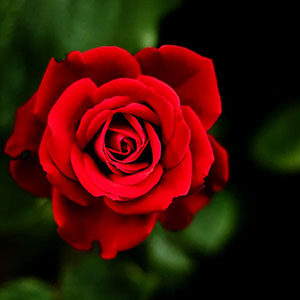
Symbolic Roses in Ancient History
There are fossil records dating roses back some 35 million years. Roses are native to the United States. Montana and Oregon have the oldest rose fossils. Along with the name Orchid, the name Rose is one of the most popular names for girls in China. Confucius wrote that the emperor of China owned over 600 books on the cultivation of roses.
Complex Family Tree of the Rose
The rose has the most complex family tree of any known flower species with over 30,000 varieties. Roses were first cultivated 5,000 years ago in Asian gardens. In the Orient, ladies carried rose petals in their purses and gentlemen made wine and herbal medicine with the flowers.
Symbolic Wild Roses
Wild roses have five petals. This has led to their symbolic connection to the wounds of Christ in Christian iconography. The rose also symbolizes the Virgin Mary herself, who was known as the “Mystic Rose.” Read more about red flower color meaning.
Symbolic Roses in Europe
Roses were introduced to Europe during the Roman Empire and were thereafter used for ornamental purposes. Romans were known to carpet huge banquet halls with rose petals. The Greek goddess of love, Aphrodite, is appropriately associated with the symbol of a rose.
Old Roses and Modern Roses
Experts divide roses into two groups. “Old roses” are those cultivated in Europe before 1800. “Modern roses” have been cultivated since about the turn of the 19th century. Before cultivation, roses typically bloomed only once per year. Now roses are blooming somewhere every day of the year.
Symbolic Roses in England
The rose is highly significant in the history of England: “The rose also became the symbol of the civil wars that took place in the 15th century in England. The House of Lancaster took the symbol of a red rose, while the House of York chose a white rose. Many years later, the two roses were combined into one symbol. The Tudor Rose became the Rose of England, which continues to be one of the most identifiable symbols in the UK.”
Resource: https://www.floraly.com.au/blogs/news/rose-symbolism-colours-and-meanings
Symbolic Roses in Rome and Egypt
Persians, Turks, and Egyptians were cultivating roses for centuries before European knights fighting in the Crusades brought roses back with them to Europe. It is said that when Cleopatra was courting Marc Antony, she would have her fountains filled with rose water and the floor covered in rose petals to welcome him.
Symbolic Roses in Egypt
Ancient Egyptians also associated roses with Isis, the goddess of love and the afterlife. Egyptians saw the cyclical blooming of roses as symbolic of death and rebirth in the afterlife. They would put rose petals in tombs and used them during the mummification process.
Fascinating Facts About Roses
Roses have been cultivated for over 5,000 years, primarily in Asia and the Middle East. The most expensive flower in the world is the Juliet rose, a pale peach colored rose that took 15 years to cultivate. It was displayed at the 2006 Chelsea Flower Show in England. The plant is valued at $15.8 million. The oldest living rose bush, called the “Thousand-year Rose”, grows on the outer wall of a cathedral in Hildesheim, Germany.
Meaning of the Apothecary’s Rose
The oldest variety of rose is the Rosa Gallica Officinalis, also known as the “Apothecary’s Rose”. This rose is still used today to produce oil, perfume, and cosmetics. Rose water is a popular flavoring ingredient in jellies and Asian dishes. Rose hips, a wild variety of roses, make a great tea that is high in Vitamin C.
Spiritual Meaning of Roses
Sufi master Hazrat Inayat Khan believed that the rose and the soul had many similarities. He viewed the rose bud opening up as a parallel to the soul experiencing God. He believed that when the basic needs of the rose and soul are met (nourishment, sunshine, water, air, space), both will blossom. Some Native American tribes saw wild roses as protective, sacred flowers. The Nez Perce, Salish, and Paiute people believed that roses protected the living from harmful spirits.
Meaning of Roses in Song and Literature
Over 4,000 songs have been written about roses. Roses are also the inspiration for everything from wallpaper to china patterns to fabric designs. Roses are a recurring theme in artwork, furniture, architecture and poetry.
Symbolic Roses in Shakespeare Plays
Shakespeare mentions the rose at least 70 times in his plays and sonnets. Roses are emblems of England and New York City. The essential oils from roses are more expensive than the essential oils of any other flower. The rose is, indeed, the queen of all flowers.
Symbolic Flowers Meaning FAITH
Flowers have often been used as a symbol of true love and faithfulness. This can be faithfulness in the sense of loyalty to another person or religious faith. True love is a strong and steadfast dedication. This can be expressed in flowers that may be small and delicate or large and bold. For in depth information on selected flowers meaning faith, see articles on Calla Lilly Meaning, Daisy Meaning, and Iris Meaning.
| Calla Lily | Compass Flower | Daisy |
| Dandelion | Iris | Lemon Blossoms |
| Passion Flower | Veronica | Violet |
Calla Lilies: Calla lily flower meanings are beauty, faith and hope. The calla lily was a sacred flower to the Minoans and to the ancient Jews. The calla lily is featured in Christian artwork. In this case, the flower represents purity and chastity. Read more about Calla Lily Meaning.
Compass Flowers: Compass flowers have leaves arranged that indicate the cardinal points of the compass. As the name suggests, compass flowers symbolize a life orientation based on spiritual principles or faith in a larger pattern or deity.
Daisy Flowers: Daisies mean beauty, patience and simplicity. Daises are the sacred flower of Freya, the most renowned of the Norse goddesses. Amazingly, this flower is more than 4,000 years old. For example, images of daisies decorate hairpins found on the island of Crete. Learn more about Daisy Meaning in flower language.
Dandelions: Dandelions symbolize the sun, the most ancient and universal of all symbols. Dandelion flower meanings are love me and affection returned. Additionally, dandelion flowers mean desire, faithful and happiness.
Iris Flowers: Iris flower meanings are faith and wisdom. On a personal level, iris flowers mean cherished friendship. They can also mean “my compliments.” Iris flowers can also mean promise in love. Historically, irises were used in gardens devoted to the Virgin Mary. Learn more about mystical Iris Flower Meaning.
Lemon Blossoms: Lemon blossoms mean faithfulness in love or “I promise to be true.” For this reason, lemon blossoms have been used traditionally in weddings. Lemons are also symbols of purification, a practical reference to their antibacterial properties.
Passion Flowers: The passion flower is named for the crucifixion of Jesus. This flower is symbolic of the scourging, crowning with thorns and suffering on the cross. Priests of the 1500s adopted this flower as a symbol and reminder of Catholic faith.
Veronica Flowers: Veronica flowers represent loyalty and fidelity in marriage. Veronica flowers are a symbol of commitment and devotion. These delicate flowers are used in wedding bouquets. Veronica is named after the Biblical woman who offered Jesus a cloth to wipe his face.
Violets: Violets are viewed as smaller forms of the lotus flower in the East, like a lotus flower with a yellow center. Modern violet flower meanings are modesty, virtue and affection. Moreover, violets can mean watchful, faithful and love.
Symbolic Flowers Meaning FREEDOM
Flowers have been used as symbols of political and personal freedom for centuries. In modern times, the tulip has been associated with freedom. After WWII, Holland shipped thousands of bulbs to Canada. This was thanks for the help of the Canadians in freeing Holland from occupation.
Symbolic Flowers and Abstract Ideas
Flowers can also be used to represent concepts and abstract ideas. These concepts may be difficult to out picture in the physical realm. Those dedicated to religions or political persuasions use flowers to convey their ideals. Find full articles on Iris Meaning and Tulip Meaning.
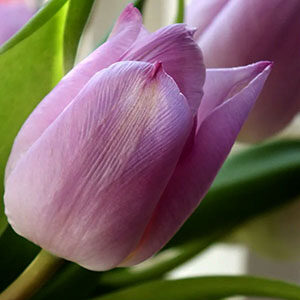
Bird of Paradise Flowers: The bird of paradise flower means freedom, good perspective and faithful. The shape of the bird of paradise flower resembles a bird–thus, the name! In South Africa the bird of paradise flower is known as the crane flower.
Chrysanthemums: There are many flower meanings for chrysanthemum! First, they mean wealth. Secondly, they mean one who is cheerful. Thirdly, they mean truth. Other meanings include hope, humility, rest, and friendship. White chrysanthemums mean freedom.
Iris Flowers: Iris flower meanings are faith and wisdom. On a personal level, iris flowers mean cherished friendship. They can also mean “my compliments.” Iris flowers can also mean promise in love. Historically, irises were used in gardens devoted to the Virgin Mary. Learn more about mystical Iris Flower Meaning.
Tulips: Tulip flowers mean fame, freedom and perfect love. The meanings also change with the color of the tulips. Red tulips mean “believe me.” They are a declaration of true love. Multicolored tulips mean “you have beautiful eyes.” Learn more about ever-popular Tulip Meaning.
Water Lilies: Water lilies are associated with spirituality and personal freedom. Like lotuses, water lilies grow out of dirty or muddy water into pristine flowers, usually white. Water lilies also symbolize rebirth or resurrection.
Symbolic Flowers Meaning FRIENDSHIP
Flowers express the essence of friendship. Various flowers express all of the subtle differences in affection, love and true caring between old and new friends.
Acacia Flowers: Acacia flowers mean perseverance and regeneration. The beauty of acacia flowers is related to purity and spiritual qualities. Acacia flowers mean loyal friendship. The quality of endurance is also associated with acacia flowers.
Arbor Vitae Flowers: Arbor Vitae flowers mean everlasting friendship. The name comes from Latin and translates as “tree of life.” The branches are used as good luck charms during New year’s celebrations in China.
Chrysanthemums: There are many flower meanings for chrysanthemum! First, they mean wealth. Secondly, they mean one who is cheerful. Thirdly, they mean truth. Other meanings include hope, humility, rest, and friendship. White chrysanthemums mean freedom.
Geraniums: n the Islamic faith, geraniums are believed to have sprung from the sweat of Muhammad. Geranium flower meanings are true friend and meeting. The genus name derives from the Greek word geranos, meaning “crane.”
Honeysuckle Flowers: Honeysuckle flowers mean both beauty and friendship. According to Greek mythology, the lovers Daphnis and Chloe lived far apart and were only allowed to see each other when the honeysuckle were blooming.
Iris Flowers: Iris flower meanings are faith and wisdom. On a personal level, iris flowers mean cherished friendship. They can also mean “my compliments.” Iris flowers can also mean promise in love. Historically, irises were used in gardens devoted to the Virgin Mary. Learn more about mystical Iris Flower Meaning.
Marigolds: Marigold meaning includes passion, creativity and happiness. In addition, marigolds are thought to be effective in stopping gossip. In India, marigolds are known as the friendship. Marigold meaning also includes the idea of cheery conversations. Read a full article on Marigolds.
Snowdrops: Snowdrop flowers mean sympathy, consolation and friendship. The white symbolizes purity and innocence. Snowdrops bloom early in the spring, making them a symbol of rebirth and hope following the winter.
Roses: The rose is the most well-known flower meaning love. The rose also symbolizes the Virgin Mary, known as the “Mystic Rose.” The rose is clearly associated with secret societies with mystical religious beliefs such as the Rosicrucians.
Symbolic Flowers Meaning GOOD FORTUNE
Flowers meaning good fortune exist in many cultures around the world. They are often associated with marriage and best wishes for the happy couple.
| Bells of Ireland | Clover | Heather |
| Lavender | Orange Blossom | Shamrock |
Bells of Ireland: These flowers are a symbol of good luck or fortune. ironically, they are actually native to Turkey and not Ireland. The name is due to their use in weddings and other ceremonies in Ireland. They are also know as Shell Flowers.
Clover Flowers: Clovers mean good luck and good fortune. If they have four leaves, this is even more fortunate! Each of the four petals have a special meaning: faith, hope, love and luck. Ireland is said to have more four-leaf clovers than any other place.
Heather Flowers: Heather flowers grow in places that are difficult for other flowers to survive. They are signs of independence and confidence as well as good luck and protection. The heather flower is especially important to Scotland.
Lavender: Lavender flowers are one of the most versatile flowers for healing. Lavender essential oil is called “the universal healer.” Lavender is particularly good for the skin. Lavender symbolizes good fortune and grace. Purchase Lavender Essential Oil from Young Living under Kathleen Karlsen and Kasondra Grillo.
Orange Blossoms: In China, orange blossoms are associated with brides. This practice spread to Europe during the Victorian era. The flowers mean good fortune and fertility. Orange blossoms have a strong, distinctive scent.
Shamrocks: Shamrocks have come to symbolize Ireland more than any other flower. The shamrock was a sacred plant to the Druids due to the formation of a triad of leaves. Shamrocks are also associated with leprechauns, other Irish legends and the “luck of the Irish.”
Symbolic Flowers Meaning HAPPINESS
Flowers are often associated with happy times—births, weddings, graduations. Read more in our article on Marigold Meaning.
| Apple Blossoms | Carnation | Chrysanthemum |
| Corchorus | Coreopsis | Crocus |
| Dandelion | Gardenia | Holly |
| Hyacinth | Lily of the Valley | Marigold |
| Rose | Stephanotis | Violet |
Apple Blossoms: Apple blossoms mean beauty in the romantic sense and as a personal preference for a particular person. Apple blossoms are also symbolic of long life and new beginnings. Apple blossoms are usually white or a beautiful pink.
Carnations: The flower meaning of the carnation is fascination. Another meaning is impulsiveness. Other meanings include joy and devoted love. Additionally, carnations mean happiness. In contrast, they also disdain and refusal (white only).
Chrysanthemums: There are many flower meanings for chrysanthemum! First, they mean wealth. Secondly, they mean one who is cheerful. Thirdly, they mean truth. Other meanings include happiness, hope, humility, rest, and friendship.
Corchorus Flowers: The common name for corchorus flowers is columbine. Columbines are associated with jesters, happiness and jocularity. The Latin name is derived from the word “eagle” due to the shape of the flower’s petals.
Coreopsis Flowers: Coreopsis flowers mean always cheerful and happiness. These blossoms can also mean “love at first sight.” Coreopsis flowers are both wild and domesticated. The blooms are yellow, a common color for flowers meaning happiness.
Crocuses: The crocus is associated with Hermes, son of Zeus and the nymph Maia. Hermes is the inventor of the lyre and the Greek god of trade, travel, wealth and good fortune. The Victorian meaning of crocuses is cheerfulness or happiness.
Dandelions: Dandelions symbolize the sun, the most ancient and universal of all symbols. Dandelion flower meanings are love me and affection returned. Additionally, dandelion flowers mean desire, faithful and happiness.
Gardenias: Gardenias are associated with Morpheus, the god of dreams and sleep. In the Victorian language of flowers, gardenia flowers mean “you’re lovely.” Secondly, they mean happiness. Thirdly, they mean purity and refinement. Finally, they mean secret love.
Holly Flowers: The Druids viewed the holly as a symbol of fertility and eternal life. In the Victorian language of flowers, the holly plant means defense. Likely this is related to the prickly leaves. Another meaning is domestic happiness.
Hyacinth Flowers: Hyacinth flowers mean games and sports. In addition, hyacinths mean rashness. They can also mean playful joy or happiness. In terms of name origins, Hyacinth is a figure in Greek mythology.
Lily of the Valley Flowers: Lilies of the Valley symbolize happiness first and foremost. They also mean purity, youthfulness and discretion. Lilies of the Valley have a fresh scent that adds to bouquets. The shape of the flowers are like little bells, purported to call fairies to meetings.
Marigold Flowers: Marigolds mean passion, creativity and happiness. Marigolds are known as the “Herb of the Sun.” The Welsh used marigolds for weather prediction. They watched to see if marigolds were open early in the morning. If not, a storm was on the way. Learn more about amazing Marigold Flower Meaning.
Roses: Yellow roses are said to mean happiness and friendship. Because roses are one of the most symbolic flowers, each color has developed its own meanings. Pink represents femininity and elegance. Red means passion and romantic love.
Stephanotis Flowers: The name Stephanotis comes from the Greek words for “crown” and “ear.” Stephanotis are a bright white color. Stephanotis are used for both weddings and funerals. These flowers mean happiness, purity and simplicity.
Violets: Violets are viewed as smaller forms of the lotus flower in the East, like a lotus flower with a yellow center. Modern violet flower meanings are modesty, virtue and affection. Moreover, violets can mean watchful, faithful and love. Finally, they mean “let’s take a chance on happiness.”
Symbolic Flowers Meaning HOPE
Flowers have long been used to encourage the ill and give hope to the grieving. Flowers bring a spot of cheer to a gloomy day. The appearance of flowers in the spring is a universal sign of hope. Particular flowers also carry the meaning of hope the whole year through! Find full article on Daffodil Meaning.
| Almond | Anemone | Chrysanthemum |
| Coreopsis | Crocus | Daffodil |
| Rose of Sharon | Snowdrop |
Almond Flowers: Almond flowers mean hope, courage and bravery. In Greek mythology, the almond flower means eternal love. Almond blossoms are white and pink. According to traditional plant lore, a almond tree growing near the house of a bride brings fertility and blessings.
Anemone Flower Language: Anemones are said to keep away evil spirits. This magical power can also be used to attract good fortune. Anemones symbolize not only beauty but red and pink anemones are connected to sincerity and death, respectively.
Chrysanthemum Flower Language: There are many flower meanings for chrysanthemum! First, they mean wealth. Secondly, they mean one who is cheerful. Thirdly, they mean truth. Other meanings include hope, humility, rest, and friendship.
Coreopsis Flowers: Coreopsis flowers mean always cheerful and happiness. These blossoms can also mean “love at first sight.” Coreopsis flowers are both wild and domesticated. The blooms are yellow, a common color for flowers meaning happiness.
Crocus Flowers: The Victorian meaning of crocuses is cheerfulness and hope. As one of the earliest flowers in the spring, crocuses add a brilliant spot of color after the long winter. The crocus is associated with the Greek god Hermes, the inventor of the lyre.
Daffodil Flowers: As the heralds of spring, daffodils are the sacred flowers of eternal life in Christian iconography. Other daffodil flower meanings are quite diverse. In the first place, daffodils are spring flowers. Thus, they mean hope and sunshine. Read full article on Daffodil Meaning.
Rose of Sharon Flowers: The Rose of Sharon symbolizes both beauty and hope. This flower is used in the Bible to describe the beauty of King Solomon’s lover. The Rose of Sharon has large blooms and grows on a bush or shrub.
Snowdrops: Snowdrop flowers mean sympathy, consolation and friendship. The white symbolizes purity and innocence. Snowdrops bloom early in the spring, making them a symbol of rebirth and hope following the winter.
Symbolic Flowers Meaning HUMILITY
Some flowers grow close to the ground. They are easily trampled by the insensitive or unknowing. This inherently makes them a symbol of humility. In addition, other flowers have been associated with the quality of humility in the language of flowers. The beauty, gentleness and vulnerability of flowers make them an ideal symbol of humility. Find full articles on Bluebell Meaning and Poppy Meaning.
Alyssum Flowers: Alyssum flowers mean “worth beyond beauty” or the beauty of the soul. Alyssum is said to bring emotional balance in gardens, homes and offices. This is a sharp contrast from the Greek name meaning “rage” or “madness”!
Baby’s Breath Flowers: Baby’s breath flowers mean purity of heart, innocence, humility and breath of the Holy Spirit. The name baby’s breath refers to gentle breath of a newborn. This name reflects the small and delicate blossoms of the flower.
Bluebells: Bluebells mean humility, gratitude, constancy and everlasting love. Bluebells are associated with humility because they grow close to the ground. Bluebells are closely linked to the realm of fairies. Therefore, they are sometimes called “fairy thimbles.” Learn all about the magical history of Bluebell Meaning.
Buttercups: Buttercups mean humility, prosperity, childishness and neatness. Buttercups are part of a large genus of 400 species. Buttercups usually flower in April or May. However, they can be found throughout the summer in some regions.
Chrysanthemums: There are many flower meanings for chrysanthemum! First, they mean wealth. Secondly, they mean one who is cheerful. Thirdly, they mean truth. Other meanings include hope, humility, rest, and friendship.
Poppy Flowers: Poppy flower primary meanings are beauty, magic, fertility and eternal life. For this reason, the Egyptians included poppies as a scared flower at funerals and in burial tombs. Additionally, poppies denote sleep, rest and repose. Interestingly, poppies also mean humility. Learn more about fascinating Poppy Flower Meaning.
Symbolic Flowers Meaning IMMORTALITY
Some flowers that bloom perennially or in spite of hard circumstances. These flowers are natural candidates for meanings related to immortality and youth. Other flowers bloom over the course of a long season. Some open and close with the cycles of each day. Find a full article on Foxglove Meaning.
Apple Blossoms: Apple blossoms mean beauty in the romantic sense and as a personal preference for a particular person. Apple blossoms are also symbolic of long life and new beginnings. Apple blossoms are usually white or a beautiful pink.
Bamboo Meaning: Bamboo plants are known for their incredible ability to grow over 3 feet in a 24 hour period. This amazing ability makes them symbolic of immortality, strength and flexibility. Bamboo is used to create high quality flooring, furniture and other household goods.
Foxglove Meaning: In Roman times, the foxglove was believed to have impregnated the goddess Hera with the god Mars. This was accomplished by the goddess Flora touching Hera with the flower on her breasts and belly. In the language of flowers, foxgloves mean immortality. Read more about flower language and Foxglove Meaning.
Globe Amaranths: Amaranth was also offered to Artemis, the Greek goddess of chastity and the hunt as well as Demeter, the goddess of the harvest. In the Victorian flower language, Globe amaranth flowers mean unfading love. In addition, they mean immortality.
Lilacs: Lilac flower meanings are beauty and innocence. In addition, they mean immortality, youth and love. Lilacs possess a strong, perfume-like scent. Additionally, they are the state flower of New Hampshire. Lilacs grow on shrubs or trees.
Poppy: Poppy flowers symbolize beauty, magic, consolation, humility, fertility, prosperity and eternal life. The bright petals of poppies are a stunning contrast in fields of green. The large, delicate petals are a unique feature of these beautiful flowers. Learn more at Poppy Flowers.
Primroses: The name Primrose means “first rose.” The Primrose is the first rose to bloom in the spring, associating this flower with rebirth and immortality. The Primrose is also symbolically connected to youthfulness and longevity.
Symbolic Flowers Meaning LOVE
Flowers are the ultimate symbol of love. Single flowers and bouquets have been given by lovers to woo their sweethearts for all of recorded history. By association these flowers can sometimes be a symbol of ardor and romantic passion as well.
Emotional Significance of Flowers
According to the highly developed tradition known as the language of flowers, each flower has a special meaning. They can convey a myriad of emotions in a discreet way. The most cherished, however, are the flowers that say “I love you.” Some are well known. Others may surprise you. Find full articles on Daffodil Meaning, Daisy Meaning, Iris Meaning, Orchid Meaning, and Tulip Meaning.
| Aster | Azalea | Bachelor Button |
| Cactus | Campion | Carnation |
| Cherry Blossom | Chrysanthemum | Cinquefoil |
| Coxcomb | Daffodil | Daisy |
| Dandelion | Everlastings | Fern |
| Forget-Me-Not | Fuschia | Gardenia |
| Gladiola | Globe Amaranth | Gloxinia |
| Honeysuckle | Impatiens | Iris |
| Lilac | Lotus | Myrtle |
| Orange Blossom | Orchid | Passion Flower |
| Rose (Red) | Tulip | Violet |
Asters: Asters mean daintiness and love. The name aster comes from the Greek word “asteri” meaning “star.” Asters were viewed as a sacred flower in ancient Greece. Aster is used as a name for both boys and girls, though primarily for girls.
Azaleas: Azaleas mean passion, love, ardor, fragility, womanhood (China) and take care of yourself for me. The name azalea is said to be related to the Hebrew name Azaliah. This means “near the Lord” or “reserved by God.”
Bachelor Buttons: According to folklore, a young man may wear a bachelor button flower to indicate his love for a young woman. If the love is unrequited, the flower fades quickly. If the love is returned, the flower remains fresh.
Cactus Flowers: The cactus flower means endurance. Another meaning is my heart burns with love. Additionally, cactus mean maternal love. The beautiful white flowers of the San Pedro are particularly beloved. These cactus flowers last less than a day but produce a fantastic aroma.
Campion Flowers: White campion flowers have petals in the shape of a heart, thus symbolizing love. Campion flowers have strong connections to myths, fairies and mystical lore. Red campions grow in woodland areas and along fields and ditches.
Carnations: The flower meaning of the carnation is fascination. Another meaning is impulsiveness. Other meanings include joy and devoted love. Additionally, carnations mean happiness. In contrast, they also disdain and refusal (white only).
Cherry Blossoms: Cherry blossoms symbolize love, spring and optimism. Cherry blossoms are particularly significant in Japan and in Buddhism. Cherry blossoms are also a symbol of honor, discipline and sacrifice, often commemorating fallen warriors.
Chrysanthemums: There are many flower meanings for chrysanthemum! First, they mean wealth. Secondly, they mean one who is cheerful. Thirdly, they mean truth. Other meanings include hope, humility, rest, and friendship. Red chrysanthemums mean “I love you.”
Cinquefoil Flowers: Cinquefoil flowers have five petals. These flowers symbolize maternal affection and love as well as prosperity and protection. The cinquefoil has been used historically in church decor. The flower grows on a shrub or bush.
Coxcomb Flowers: Coxcomb flowers mean love and affection. They are believed to have magical powers. Coxcomb flowers make a romantic gift for a spouse or lover. Coxcomb is also appropriate for friends, indicating light-hearted fun and affection.
Daffodil Flowers: As the heralds of spring, daffodils are the sacred flowers of eternal life in Christian iconography. Other daffodil flower meanings are quite diverse. In the first place, daffodils are spring flowers. Thus, they mean hope and sunshine. Learn more about beautiful Daffodil Meaning.
Daisies: Daisies mean beauty, patience and simplicity. Daises are the sacred flower of Freya, the most renowned of the Norse goddesses. Amazingly, this flower is more than 4,000 years old. For example, images of daisies decorate hairpins found on the island of Crete. Read all about Daisy Meaning.
Dandelions: Dandelions symbolize the sun, the most ancient and universal of all symbols. Dandelion flower meanings are love me and affection returned. Additionally, dandelion flowers mean desire, faithful and happiness.
Everlastings: Everlastings include any flower that retains their shape and color long after being picked. Thus, they symbolize everlasting love. Helichrysum is a specific kind of everlasting, sometimes known as Immortelles.
Fern Meaning: The meanings of ferns are magic and fascination. In addition, ferns mean confidence and shelter. Other sources say ferns mean discretion and reverie. Ferns can also mean a secret bond of love. Ferns are one of the oldest living plants on earth.
Forget-Me-Nots: Forget-me-nots mean true love and memories. There is a legend that Christ was sitting on Mary’s lap. She wished future generations could see them. Jesus waved his hand over the ground. Blue forget-me-nots appeared.
Fuschia Flowers: In Ireland, the fuchsia flower is called “Deora De” meaning the teardrops of God. Fuchsia flower meaning is confiding love. Fuchsia flowers are a decorative eardrop shape. They grow throughout the summer and autumn.
Gardenias: The ancient Greeks believed that a person smelling gardenias could be transported to the Elysium paradise. In the Victorian language of flowers, gardenia flowers mean “you’re lovely,” happiness and purity. Finally, they mean secret love.
Gladiola Flowers: Gladiola mean splendid beauty. They also mean preparedness and strength. In addition, gladiolus can mean love at first sight. The name gladiolus flowers derives from the shape of the leaves. This is because the leaves resemble a “gladius” or sword.
Globe Amaranths: Amaranth was also offered to Artemis, the Greek goddess of chastity and the hunt as well as Demeter, the goddess of the harvest. In the Victorian flower language, Globe amaranth flowers mean unfading love. In addition, they mean immortality.
Gloxinia Flowers: Gloxinia flowers mean “love at first sight.” Gloxinias were a favorite floral gift for men during Victorian times as they as mean “a proud spirit.” These flowers also mean leadership, individuality and a pioneering spirit.
Honeysuckle Flower Language: Honeysuckle flowers mean both beauty and friendship. They also mean love. According to Greek mythology, the lovers Daphnis and Chloe lived far apart and were only allowed to see each other when the honeysuckle were blooming.
Impatiens: Impatiens flower meaning is motherly love. In medieval gardens devoted to the Virgin Mary, impatiens were called “Our Lady’s earrings.” There are approximately 1,000 species of impatiens flowers. Only a few are grown in modern gardens.
Iris Flower Language: Iris flower meanings are faith and wisdom. On a personal level, iris flowers mean cherished friendship. They can also mean “my compliments.” Iris flowers can also mean promise in love. Historically, irises were used in gardens devoted to the Virgin Mary. Learn more about flower language and Iris Flower Meaning.
Lilac Flowers: Lilac flower meanings are beauty and innocence. In addition, they mean immortality, youth and love. On the other hand, lilacs also mean pride. Lilacs possess a strong, perfume-like scent. Lilac is also the name of a pale shade of purple.
Lotus Flowers: Lotus flowers serve as a symbol of spiritual enlightenment. They mean purity, rebirth and divinity. As a consequence, the lotus is the national flower of India. Negative meanings for the lotus are estranged love and forgetfulness.
Myrtle Blossoms: The word “myrtle” simply means “sprig” in Greek. The myrtle tree and flowers are symbols of love, fortune and prosperity. The myrtle tree is associated with Aphrodite, Greek goddess of love and beauty. Myrtle trees were typically planted in Aphrodite’s temple gardens.
Orange Blossoms: In China, orange blossoms are associated with brides. This practice spread to Europe during the Victorian era. The flowers mean good fortune and fertility. Orange blossoms have a strong, distinctive scent.
Orchid Flowers: Orchid flowers mean love and beauty. Other meanings include children, thoughtfulness and mature charm. Orchids are also viewed as sacred flowers of the Holy Spirit. The spots that often appear on their petals are symbolic of the blood of Christ. Full article on Orchid Flower Meaning available.
Passion Flowers: The passion flower is named for the crucifixion of Jesus. This flower is symbolic of the scourging, crowning with thorns and suffering on the cross. Priests of the 1500s adopted this flower as a symbol and reminder of Catholic faith.
Roses: Yellow roses are said to mean happiness and friendship. Because roses are one of the most symbolic flowers, each color has developed its own meanings. Pink represents femininity and elegance. Red means passion and romantic love.
Tulips: Tulip flowers mean fame, freedom and perfect love. The meanings also change with the color of the tulips. Red tulips mean “believe me.” They are a declaration of true love. Multicolored tulips mean “you have beautiful eyes.” Learn all about the fascinating history of Tulip Meaning.
Violets: Violets are viewed as smaller forms of the lotus flower in the East, like a lotus flower with a yellow center. Modern violet flower meanings are modesty, virtue and affection. Moreover, violets can mean watchful, faithful and love. Finally, they mean “let’s take a chance on happiness.”
Symbolic Flowers Meaning PASSION
Many flowers are related to the ideas of passion, love and romance. A list of flowers with the meaning of passion is given below. Learn more in articles on Camellia Meaning, Daffodil Meaning, Daylily Meaning, Iris Meaning, Marigold Meaning, and Tulip Meaning.
Camellias: Camellia flower meaning is everlasting love. For one thing, camellias bloom for many months. In contrast, other flowers may bloom for only a few weeks. For this reason, lovers give camellias to express ongoing devotion. Read an article on flower language and Camellia Meaning.
Chrysanthemums: There are many flower meanings for chrysanthemum! First, they mean wealth. Secondly, they mean one who is cheerful. Thirdly, they mean truth. Other meanings include passion, hope, humility, rest, and friendship.
Daffodil Flowers: As the heralds of spring, daffodils are the sacred flowers of eternal life in Christian iconography. Other daffodil flower meanings are quite diverse. In the first place, daffodils are spring flowers. Thus, they mean hope and sunshine. Learn more about Daffodil Meaning.
Daylily Flowers: For the Chinese, the daylily means filial love and devotion to one’s mother. Beginning in the Victorian era with the language of flowers, daylily flower meaning includes “forgetting worries” and “flirtatious.” Red lilies symbolize passion and love. Read more about Daylily Meaning.
Iris Flower Language: Iris flower meanings are faith and wisdom. On a personal level, iris flowers mean cherished friendship. They can also mean “my compliments.” Iris flowers can also mean promise in love and passion. Historically, irises were used in gardens devoted to the Virgin Mary. Learn more about this amazing flower in Iris Meaning.
Marigold Flowers: Marigolds mean passion, creativity and happiness. Marigolds are known as the “Herb of the Sun.” The Welsh used marigolds for weather prediction. They watched to see if marigolds were open early in the morning. If not, a storm was on the way. Learn all about flower language and Marigold Meaning.
Peach Blossoms: Peach blossoms symbolize romance, passion and womanhood. Peach blossoms and peaches are highly symbolic in China. The fruit and flowers mean longevity. The fruit is typically eaten as part of New Year’s celebrations.
Rhododendron: A token of affection, often red for passion and energy. The word “rhododendron” means “rose tree.” This flower has many of the same connotations for love and physical ardor. Other meanings include solid and steadfast.
Roses: Yellow roses are said to mean happiness and friendship. Because roses are one of the most symbolic flowers, each color has developed its own meanings. Pink represents femininity and elegance. Red means passion and romantic love.
Tulips: Orange tulips mean energy, desire, and passion. Other colors of tulips mean fame, freedom and perfect love. Red tulips mean “believe me.” They are a declaration of true love. White tulips symbolize heaven, newness and purity. Purple tulips mean royalty. Learn about the fascinating history of Tulip Meaning.
Symbolic Flowers Meaning PROSPERITY
An abundance of flowers in the home is sure to uplift the spirits and fortunes of all inhabitants! Some flowers are associated with prosperity simply because they grow aggressively. This multiplies their numbers quickly. Others are associated with wealth due to their color (yellow representing gold and wealth). Find full articles on Daffodil Meaning and Poppy Meaning.
Bamboo Meaning: Bamboo plants are known for their incredible ability to grow over 3 feet in a 24 hour period. This amazing ability makes them symbolic of immortality, strength and flexibility. Bamboo is used to create high quality flooring, furniture and other household goods.
Buttercups: Buttercups mean humility, prosperity, childishness and neatness. Buttercups are part of a large genus of 400 species. Buttercups usually flower in April or May. However, they can be found throughout the summer in some regions.
Cattail Symbolism: Cattails meanings are peace and prosperity. Cattails are also known as bulrushes. The pollen of the cattail is considered to be sacred by the Apache Indians. The pollen is called hoddentin and is used in many rituals and ceremonies including weddings and blessings.
Chrysanthemums: There are many flower meanings for chrysanthemum! First, they mean wealth. Secondly, they mean one who is cheerful. Thirdly, they mean truth. Other meanings include hope, humility, rest, and friendship. Red chrysanthemums mean “I love you.”
Daffodil Flowers: As the heralds of spring, daffodils are the sacred flowers of eternal life in Christian iconography. Other daffodil flower meanings are quite diverse. In the first place, daffodils are spring flowers. Thus, they mean hope and sunshine. Read more about Daffodil Flower Meaning.
Lunaria Flowers: In the Victorian flower language, lunaria flowers mean honesty, prosperity and sincerity. The flower is also thought to be a spiritual protection. Lunaria is sometimes called the money plant due to is silver, coin-shaped seed pods.
Peony Flowers: Modern peony flower meanings are happy marriage and romance. Equally important, peonies signify wealth and prosperity. Peonies are known for for their large, scented flowers. Peonies were formerly used in medicine.
Poppy Flowers: Poppy flower meanings are beauty, magic, fertility and eternal life. For this reason, the Egyptians included poppies as a scared flower at funerals and in burial tombs. Additionally, poppies denote sleep, rest and repose. Finally, poppies mean prosperity. Learn about the amazing history of Poppy Flower Meaning.
Symbolic Flowers List
Acacia Flower: perseverance, regeneration
Almond Flower: hope, courage, bravery
Alyssum: beauty of the soul, balance
Anemone: protection, good fortune
Amaryllis: pride, strength, determination
Anemone: protection, good fortune
Apple Blossom: beauty, I prefer you
Arbor Vitae: everlasting friendship
Aster: daintiness and love
Azalea: passion, love, ardor, fragility
Baby’s Breath: purity of heart, innocence
Bachelor Button: celibacy, I am single
Bamboo: immortality, strength, flexibility
Bauhinia: harmony, wisdom and peace
Begonia: fanciful nature, beware
Bells of Ireland: good luck, fortune
Bird of Paradise: freedom
Bluebell: humility, gratitude, constancy
Buttercup: humility, prosperity, childishness
Cactus Flower: endurance, burning with love
Calendula: winning grace, grief
Calla Lily: beauty, faith and hope
Camellia: everlasting love
Campion: love, fairies, mystical lore
Carnation: fascination, impulsiveness
Cattail: peace and prosperity
Chamomile: energy in action
Cherry Blossom: education and love
Christmas Rose: the Christ child
Cinquefoil: prosperity, affection, protection
Chrysanthemum: wealth, cheer, hope
Clover: good luck, good fortune
Corchorus: happiness, jocularity
Coreopsis: love at first sight, cheerfulness
Cowslip: beauty, winning grace
Coxcomb: love, affection, magic
Crocus: cheerful
Cyclamen: sacred flowers of love
Daffodil: dignity and elegance
Daisy: purity and innocence
Dandelion: desire, faithful and happiness
Delphinium: lightness and levity
Edelweiss: daring, courage, noble purity
Everlastings: everlasting love
Fern: magic and fascination
Forget-Me-Not: true love and memories
Foxglove: immortality, insincerity
Fuchsia: confiding love
Gardenia: secret love
Geranium: true friend and meeting
Gerbera: happiness, simple beauty
Gladiola: fallen heroes, preparedness
Globe Amaranth: unfading love
Gloxinia: love at first sight, proud spirit
Heather: independence, confidence
Hibiscus: delicate beauty
Holly: fertility and eternal life
Honeysuckle: friendship and beauty
Huckleberry: faith and simple pleasures
Hyacinth: games and sports
Impatiens: motherly love
Iris: faith and wisdom
Ivy: eternal nature of the soul
Jasmine: attachment and sensuality
Lady’s Mantle: a cloak for the Blessed Virgin
Lavender: good fortune, grace, healing
Lemon Blossom: I promise to be true
Lilac: beauty and innocence
Lily: devotion to one’s mother
Lily of the Valley: happiness, purity, youth
Lotus: spiritual enlightenment
Lunaria: honesty, sincerity, prosperity
Lupine: imagination
Magnolia: nobility and love of nature
Marigold: passion, creativity and happiness
Marjoram: joy and happiness
Morning Glory: eternal love
Myrtle: love, fortune, prosperity
Narcissus: self-esteem and vanity
Nasturtium: victory in battle, conquest
Orange Blossom: sacred marriage
Orchid: love and beauty
Pansy: merriment
Passion Flower: faith, passion of Jesus
Peach Blossom: womanhood, romance
Peony: happy marriage and romance
Petunia: your presence soothes me
Poinsettia: symbol of purity
Poppy: beauty, magic, fertility, death, life
Primrose: rebirth, immortality, longevity
Pussy Willow: motherhood
Rhododendron: beauty, caution, passion
Rose: love, beauty, friendship (yellow)
Rose of Sharon: beauty, hope
Shamrock: good fortune
Snapdragon: graciousness and strength
Snowdrop: sympathy, consolation
Stephanotis: purity, simplicity
Sunflower: adoration
Sweet Pea: blissful, delicate pleasure
Tulip: fame, freedom, perfect love
Verbena: pray for me, sensibility
Veronica: loyalty, fidelity
Violet: watchful, faithful and love
Water Lily: spirituality, personal freedom
Wisteria: welcome, playful
Zinnia: lasting affection, constancy
Symbolic Flowers in Art and Décor
The appeal of flower paintings and symbolic flowers in all forms of decor is timeless and crosses all national boundaries. Top publishers continue to find that flower paintings are successful in nearly all markets and in nearly all price ranges. Not only do flower paintings cross all demographic groups by income and education, but flower paintings appeal to people in all age groups as well.
Popularity of Flower Paintings
Over sixty percent of all decorative retail art is flower paintings. The wide range of forms from the simple and bold to the complex and delicate ensure a remarkable diversity in flower paintings. Although roses are a perennial favorite, retailers agree that just about any flower painting will appeal to a certain segment of the population. It appears that flower paintings will continue indefinitely to be a “growing” market.
Flowers on Clothing and Housewares
With the advent of modern reproduction techniques and the ability to create mass-produced clothing and housewares, symbolic flowers continue to be utilized in all aspects of self-adornment and interior design. Their inherent beauty and the mystical qualities expressed in their symbolic meanings ensure the ongoing popularity of images and objects featuring flowers!
Therapeutic Value of Symbolism
Researchers are now also discovering the therapeutic value of positive visual symbols in healing art. This symbolism can be a part of healing art due to the colors utilized, the subjects depicted or the patterns of eye movement created in the viewer. Symbolic flowers are among the more prominent forms that can add healing value to art.
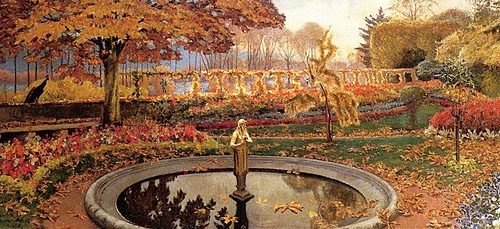
Symbolic Flowers in Mary Gardens
In the late Middle Ages, depictions of the Virgin Mary in an idealized garden were common in Flemish and German paintings. The flower symbolism in the gardens depicted represented Mary’s virtues and significant events in her life. Some churches began creating actual gardens devoted to Mary, the Mother of Jesus, for worshippers to visit for meditation and prayer. These gardens had both symbolic and spiritual dimensions and would include flowers based on flower symbolism associated with Mother Mary.
Symbolism of the Enclosed Garden
The enclosed garden, or “hortus conclusus,” could also represent the human soul enclosed in a body or the faithful enclosed in the body of the church. Flowers relating specifically to Mother Mary that could be included in such gardens are discussed in this chapter. Although there are a few churches that still have Mary Gardens, altars dedicated to Mother Mary are more common now and can also employ flowers and flower paintings involving appropriate flower symbolism.
Flower Offerings to Religious Statues
Laying flowers at the feet of religious statues is a traditional practice. In modern homes, silk flowers or flower paintings in association with altars have become popular. Altars in honor of saints, religious leaders, angels or other spiritual beings can be created with symbolic flowers in mind. Learn more about Sacred Flowers from around the world.
Specific Symbolic Flowers in Mary Gardens
Christmas Rose: The Christmas rose is purported to have flowered on Christmas Day and is therefore associated with the infant Jesus. The Christmas Rose is a member of the genus Helleborus and is not related to the rose bush. The Christmas Rose is frost resistant. Many species are evergreens. The Christmas Rose in Mary Gardens bears pure white or pink flowers. They are sometimes known as the Lenten Rose.
Cowslip Flowers: In medieval times, Mary was often referred to as “Our Lady.” Cowslip was called “Our Lady’s Keys.” Cowslip is also known as marsh marigold and grows in wet, boggy places, such as marshes, fens, ditches and wet woods. Cowslip is most luxuriant in partial shade.
Daisies: The flower symbolism associated with the daisy is purity, innocence, loyal love, beauty, patience and simplicity. Daisies are often depicted in meadows in medieval paintings, also known as a “flowery mead.” Daisies have also been associated with the shroud of Turin. Find out more in the article Daisy Meaning in Mythology, Religion & Around the World.
Forget-Me-Not Flowers: The flower symbolism associated with the forget-me-not is true love and memories. There are legends that the Christ child was sitting on Mary’s lap one day and said that he wished that future generations could see them. He touched her eyes and then waved his hand over the ground and blue forget-me-nots appeared.
Foxglove Flowers: The flower symbolism associated with the foxglove is stateliness and youth. Foxglove flowers have both positive and negative symbolic meanings. They are said to sometimes hurt and sometimes heal. The scientific name is digitalis, a reference to the presence of powerful chemicals that can heal heart conditions if taken correctly but can kill if taken in large amounts. Foxglove are known as “Our Lady’s Gloves.” Learn all about this fascinating flower in the article Foxglove Flower Meaning: Fairies, Immortality, Medicine & Poison.
Heartsease (Pansy) Flowers: The flower symbolism associated with heartsease is due to its combination of three colors: white, yellow and purple. Heartsease is known as the “Herb Trinity” and was common in medieval paintings of Mother Mary. Heartsease is also known secularly as the pansy or Johnny Jump Up. The flower symbolism associated with the pansy is merriment and you occupy my thoughts. The name pansy is derived from the French word pensée meaning “thought,” and was so named because the flower resembles a human face. In August the pansy is thought to nod forward as if deep in thought.
Iris Flower Symbolism: The flower symbolism associated with the iris is faith, wisdom, cherished friendship, hope, valor, my compliments, promise in love, and wisdom. The blade-shaped foliage denotes the sorrows which “pierced her heart.” The iris is the emblem of both France and Florence, Italy. More in the article Iris Flower Meaning: Royalty, Faith & the Symbolic Trinity.
Lady’s Mantle: The Lady’s Mantle plant has leaves that are said to be a cloak for the Blessed Virgin. Lady’s Mantle is known for a spray of yellow flowers. This flowering plant grows slowly through rhizomes. Lady’s Mantle is a typical flower in European cottage gardens.
Lily Flowers: The flower symbolism associated with the lily is chastity, virtue, fleur-de-lis, Holy Trinity, faith, wisdom, chivalry, royalty sweetness, virginity, purity and majesty. The flower symbolism of lilies is associated with the annunciation of the birth of Jesus by the angel Gabriel. In both Christian and pagan traditions, lilies symbolize fertility. In Greek marriage ceremonies, the bride wears a crown of lilies. Read more about Daylily Flower Meaning.
Lily of the Valley Flowers: The flower symbolism associated with the lily of the valley is “Our Lady’s Tears.” The lily of the Valley was said to have grown where Mother Mary wept. The lily of the valley was used to decorate churches dedicated to Mother Mary and was shown growing in the grass beneath Mary’s feet in paintings by Jan Van Eyck.
Lungwort Flowers: Like the lily of the valley, the flower symbolism associated with lungwort is also “Mary’s Tears.” The white spots on the leaves are her tear stains and the changing color of the flowers from pink to red represent her blue eyes reddened with weeping.
Marigold Flowers: The flower symbolism associated with marigolds is indicated in the name: Mary’s Gold. Marigold flowers were “golden gifts” offered to Mother Mary by the poor who could not afford to give actual gold. Marigolds were also planted in Mary Gardens. They are symbolic of passion and creativity. Find more in Marigold Meaning in Romance, Astrology & Religion.
Peony Flowers: Mary Garden Symbolism The flower symbolism associated with the peony is happy marriage and compassion. Peonies are extensively grown as ornamental plants for their large, often scented flowers. Peonies were often featured in medieval paintings and tapestries depicting Mother Mary.
Periwinkle Flowers: The flower symbolism associated with the periwinkle is related to references to Mother Mary as the “Star of the Sea.” This connection extends to the periwinkle flower due to its blue, star-shaped flowers. The periwinkle grows as a shrub.
Pinks: The flower symbolism associated with pinks is that of the Virgin’s premonition of Christ’s Passion. Also known as the Gilly Flower, they are said to have appeared when Mother Mary wept at the Crucifixion. The Madonna of the Pinks (circa 1506-1507) is an early devotional painting by the Italian Renaissance master Raphael.
Primrose Flowers: The primrose is associated with the month of May and was used to decorate altars for May Day, a celebration in which statues of Mother Mary are crowned with garlands of flowers. There are approximately two dozen different types of primroses including garden flowers and wild varieties.
Roses: The flower symbolism associated with roses is love, remembrance, passion (red); purity (white); happiness (pink); infidelity (yellow); unconscious beauty, I love you. The rose symbolizes the Virgin Mary herself, who was known as the “Mystic Rose.”
Rosemary: The pale blue flowers of rosemary are said to have taken their color from Mother Mary’s veil when she spread it over a rosemary bush. Rosemary has a very old reputation for improving memory and has been used as a symbol for remembrance (during weddings, war commemorations and funerals).
Snowdrops: The snowdrop flower is also known as “Our Lady’s Bells” and is used during Candlemas, a celebration of The Feast of the Presentation of Christ in the Temple, also known as The Purification of Saint Mary the Virgin, which is on February 2nd. Snowdrops are among the first bulbs to bloom in spring.
Star of Bethlehem Flowers: The Star of Bethlehem is a reminder of Jesus’ birth at Christmas. The Star of Bethlehem grows from a bulb and is native to southern Europe. The Star of Bethlehem has grass-like basal leaves and a slender stalk, up to 30 cm tall, bearing clusters of star-shaped white flowers striped with green.
Violet Flower Symbolism: The flower symbolism associated with violets is modesty, virtue, affection, watchfulness, faithfulness, love and let’s take a chance on happiness. The violet’s color, delicacy, sweet scent and heart-shaped leaves refer to Mary’s constancy, modesty and innocence. The violet is also known as “Our Lady’s Modesty.”
Wild Strawberry: The wild strawberry is designated as the fruit of the Virgin Mary and of blessed souls in heaven. Wild strawberries are depicted growing in the grass beneath the Virgin’s feet in paintings by Jan Van Eyck.
The Biological Role of Flowers
Flowers have practical purposes as well as symbolic and religious ones. Flowers are the reproductive part of angiosperms or flowering plants. Flowers consist of the exterior petals, the central pistil and the surrounding stamen. Some flowers are self-pollinating, while others require insects, wind or other means of cross-pollination.
Flowers as Food
Flowers are sources of food for both animals and insects. The incredible beauty of many flowers have given them their added importance as decorative objects. Flowers have been grown in gardens and arranged in bouquets on virtually every continent on earth. Symbolic flowers have also been used as adornment for centuries.
Famous Flower Quotes

Perfumes are the
feelings of flowers.
Heinrich Heine

Of all flowers,
methinks a rose is best.
William Shakespeare

I’d rather have roses
on my table
than diamonds
on my neck.
Emma Goldman

Where flowers bloom,
so does hope.
Lady Bird Johnson

Be like the flower,
turn your faces to the sun.
Kahlil Gibran

We can complain because rose bushes have thorns or rejoice because thorn bushes have roses.
Abraham Lincoln

The violets in the mountains
have broken the rocks.
Tennessee Williams

I will touch a hundred flowers and not pick one.
Edna St. Vincent Millay

‘Tis my belief
that every flower
Enjoys the air
it breathes.
William Wordsworth
More Flower Articles
SYMBOLIC FLOWERS ARTICLE SUMMARY
This article includes fascinating facts about the symbolic flowers throughout history. Topics range from ancient times to modern poetry to the biological role of flowers. Enjoy famous flower quotes from political figures, writers and musicians. Explore the power of symbolic flowers!
Author Kathleen Karlsen
Kathleen Karlsen is a musician, artist, writer and speaker. She is the author of two books (Flower Symbols and Vocal Medicine) and over 200 articles. Kathleen, her husband Andrew, and their five children live in Bozeman, Montana. More about Kathleen Karlsen.

